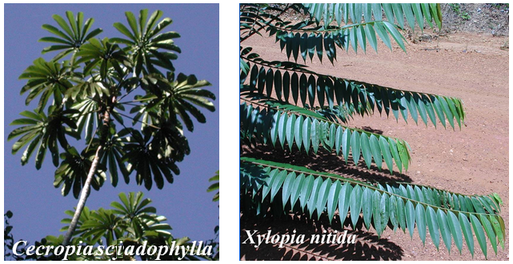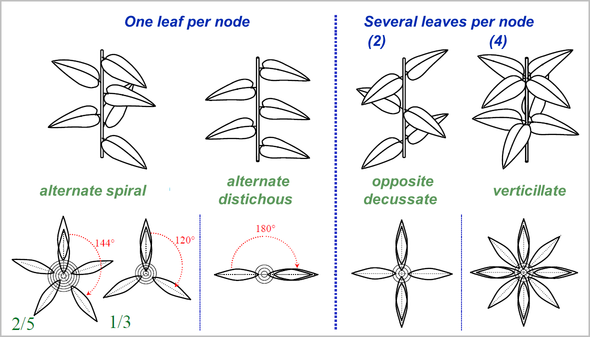Preliminary Course
Botany. Architectural Analysis
Axis orientation and phyllotaxis.
Growth direction
-
On most plants and more evidently in trees, two major types of axes may be distinguished
according to their vertical or horizontal growth direction.
Orthotropy refers to axes whose general orientation is vertical and whose symmetry is radial, with leaves in a spiral, opposite or verticillate arrangement, and associated lateral branches arranged in all spatial directions.
Plagiotropic axes have a general horizontal to slanted orientation and a bilateral symmetry owing to leaves and branches being generally arranged in one plane.
Some stems can be orthotropic then plagiotropic, or vice versa; they are called mixed axes.
Lastly, some stems have no particular orientation and are called ageotropic.

Growth orientation (Photos D. Barthélémy)
Left: Orthotropic stem (Cecropia sciadophylla)
Right: Plagiotropic branches (Xylopia nitida)
In the aboveground vegetative part of most woody plants, orthotropy is generally associated with plant skeleton construction and the colonization or exploration of the vertical space, whereas plagiotropy is generally more concerned with exploration and exploitation of the horizontal space and reproductive functions (photosynthesis, flowering).
These terms can also be used to describe root axes.
Phyllotaxis
-
Phyllotaxis represents the leaf arrangement along an axis.
The main common arrangements are the alternate spiral for an orthotropic axis, and alternate distichous (bilateral symmetry, all leaves lie in the same plane).
The term verticil or whorl concerns the arrangement when more than one leaf is inserted at the same node.
Opposite decussate defines the specific case of two leaves per node.

Phyllotaxis
Classic phyllotaxis on an orthotropic axis (Drawing P. Heuret, INRA)
Definition
